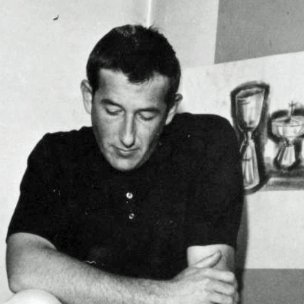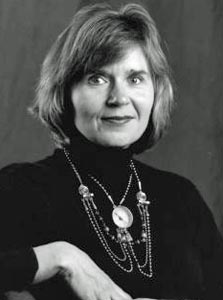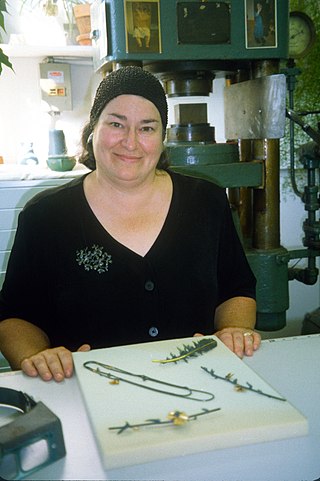
Mary Lee Hu (born 1943 in Lakewood, Ohio) is an American artist, goldsmith, and college level educator known for using textile techniques to create intricate woven wire jewelry. [1]

Mary Lee Hu (born 1943 in Lakewood, Ohio) is an American artist, goldsmith, and college level educator known for using textile techniques to create intricate woven wire jewelry. [1]
Hu first became fascinated with metalwork during high school introductory courses. She later explored more work with metals during a summer camp. [2] She went on to attend Miami University in Oxford, Ohio, for two years and then went to Cranbrook Academy of Art in Bloomfield Hills, Michigan to complete her undergraduate degree. During her undergraduate education Hu developed her skills and continued to work with small scale metalwork and jewelry. In 1966 while earning her graduate degree in Metalsmithing from Southern Illinois University in Carbondale, Illinois, Hu studied under renowned metalsmith L. Brent Kington. It was during this time that Hu started to work with fiber inspired techniques after taking a fiber arts course. [3] This led to the development of her signature style of wire wrapped jewelry. Since the late 1960s Hu has developed new techniques in coiling, wrapping, weaving, knitting, and twining wire. Her work consists mostly woven wire earrings, rings, bracelets, brooches, and neckpieces that emulate natural forms, movements and symmetry. [4]
After completing her master of fine arts degree, Hu traveled to various places and took up different teaching positions until she joined the metal arts program in the University of Washington in the School of Art in 1980. She retired from the University of Washington as professor emeritus in 2006. [5]
Hu is a member and past president of the Society of North American Goldsmiths.[ when? ] In 1996 Hu was inducted into the American Craft Council College of Fellows. [6] Hu has received three National Endowment of the Arts Craftsman Fellowships. Her work is in major collections such as the Victoria and Albert Museum, the Renwick Gallery, the American Crafts Museum and the Art Institute of Chicago. Hu is the winner of the 2008 Irving and Yvonne Twining Humber Award for Lifetime Artistic Achievement. [7]

Albert Paley is an American modernist metal sculptor. Initially starting out as a jeweler, Paley has become one of the most distinguished and influential metalsmiths in the world. Within each of his works, three foundational elements stay true: the natural environment, the built environment, and the human presence. Paley is the first metal sculptor to have received the Lifetime Achievement Award from the American Institute of Architects. He lives and works in Rochester, New York with his wife, Frances.
Arline Fisch is an American artist and educator. She is known for her work as a metalsmith and jeweler, pioneering the use of textile processes from crochet, knitting, plaiting, and weaving in her work in metal. She developed groundbreaking techniques for incorporating metal wire and other materials into her jewelry.
Robert Ebendorf is an American metalsmith and jeweler, known for craft, art and studio jewelry, often using found objects. In 2003–2004, the Smithsonian American Art Museum organized an exhibition of 95 pieces, titled The Jewelry of Robert Ebendorf: A Retrospective of Forty Years.
Kiff Slemmons is a contemporary American metalsmith. She received her B.A. in Art and French at the University of Iowa, but is primarily known for her career in jewelry and metals. Slemmons currently resides in Chicago, Illinois. Her work is collected by many notable museums and personalities, including the late Robin Williams.
Stanley Lechtzin is an American artist, jeweler, metalsmith and educator. He is noted for his work in electroforming and computer aided design (CAD) and computer aided manufacture (CAM). He has taught at Temple University in the Tyler School of Art and Architecture, from 1962.

L. Brent Kington was an art educator and visual artist who worked in blacksmithing and sculpture. Kington was a product of the studio craft movement in jewelry and hollowware. In 1969 he served as the first president of the Society of North American Goldsmiths. He is frequently hailed as the man responsible for the blacksmithing revival which took place in the late 1960s and early 1970s.

Fred Fenster is a metalsmith and professor emeritus of the University of Wisconsin at Madison where he taught art and education. He is particularly known for his work in pewter, influencing generations of metalsmiths. Fenster was named a Fellow of the American Craft Council in 1995.
Heikki Markus Seppä, also known as Heiki Seppa was a Finnish-born American master metalsmith, educator, and author. He taught at Washington University in St. Louis, from 1965 to 1992.
Gary Lee Noffke is an American artist and metalsmith. Known for versatility and originality, he is a blacksmith, coppersmith, silversmith, goldsmith, and toolmaker. He has produced gold and silver hollowware, cutlery, jewelry, and forged steelware. Noffke is noted for his technical versatility, his pioneering research into hot forging, the introduction of new alloys, and his ability to both build on and challenge traditional techniques. He has been called the metalsmith's metalsmith, a pacesetter, and a maverick. He is also an educator who has mentored an entire generation of metalsmiths. He has received numerous awards and honors. He has exhibited internationally, and his work is represented in collections around the world.

Nancy Lee Worden was an American artist and metalsmith. Her jewelry art is known for weaving together personal narratives with current politics. She received many awards and honors. Worden exhibited internationally, and her work is represented in collections around the world, including the Smithsonian American Art Museum and the Museum of Fine Arts, Boston.
Donald Paul Tompkins (1933–1982) is an American jewelry artist known for his witty and satirical works based on objects, photo etchings, cast elements, and gemstones. He is most closely associated with the Pacific Northwest and the metalsmithing community that coalesced around Central Washington University in Ellensburg, Washington, where he taught for many years. His most famous series Commemorative Metals keenly reflected Pop Art and the artistic concerns of New York City-based artists in the 1950s and 60s.
Susie Ganch is a first generation American artist of Hungarian heritage. She is a sculptor, jeweler, educator, and founder and director of Radical Jewelry Makeover. Ganch received her Bachelors in Science from the University of Wisconsin-Madison in Geology in 1994 and her Masters in Fine Arts from the University of Wisconsin-Madison in 1997.
Lauren Kalman is a contemporary American visual artist who uses photography, sculpture, jewelry, craft objects, performance, and installation. Kalman's works investigate ideas of beauty, body image, and consumer culture. Kalman has taught at institutions including Brown University and the Rhode Island School of Design. Currently she is an associate professor at Wayne State University.
Myra Mimlitsch-Gray is an American metalsmith, artist, critic, and educator living and working in Stone Ridge, New York. Mimlitsch-Gray's work has been shown nationally at such venues as the John Michael Kohler Arts Center, Museum of the City of New York, Metropolitan Museum of Art, Cooper-Hewitt Smithsonian Design Museum, and Museum of Arts and Design. Her work has shown internationally at such venues as the Middlesbrough Institute of Modern Art, Stadtisches Museum Gottingen, and the Victoria and Albert Museum, and is held in public and private collections in the U.S, Europe, and Asia.
Linda Threadgill is an American artist whose primary emphasis is metalsmithing. Her metal work is inspired by forms of nature and the interpretations she gleans from the intricate patterns it presents. She explores the foundation of nature to allude to nature and transform it into re-imagined, stylized plants forms.

Marjorie Schick was an innovative American jewelry artist and academic who taught art for 50 years. Approaching sculptural creations, her avant-garde pieces have been widely collected. Her works form part of the permanent collections of many of the world's leading art museums, including the Hermitage Museum in Saint Petersburg, Russia; the Museum of Arts and Design in New York City; the National Museum of Modern Art in Kyoto, Japan; the Philadelphia Museum of Art in Pennsylvania; and the Victoria and Albert Museum of London.

Jan Yager is an American artist who makes mixed media jewelry. She draws inspiration from both the natural world and the lived-in human environment of her neighborhood in Philadelphia, Pennsylvania, emphasizing that art is a reflection of both time and place. She has incorporated rocks, bullet casings, and crack cocaine vials into her works, and finds beauty in the resilience of urban plants that some would consider weeds.

Merry Renk, also known as Merry Renk-Curtis, was an American jewelry designer, metalsmith, sculptor and painter. In 1951, she helped to found the Metal Arts Guild (MAG), and served as its president in 1954.
Sharon Church was an American studio jeweler, metalsmith, and educator. She is a professor emerita of the University of the Arts (Philadelphia) in Philadelphia, Pennsylvania. In 2012, Church was elected a Fellow of the American Craft Council (ACC). In 2018, she received a Lifetime Achievement Award from the Society of North American Goldsmiths.
Marilyn da Silva is an American sculptor, metalsmith, jeweler, and educator. She teaches and serves as a department head at the California College of the Arts in the San Francisco Bay Area. Da Silva has won numerous awards including honorary fellow by the American Craft Council (2007).
Hu has blazed a trail both as artist and innovator, exploring the nexus between metalsmithing and textile techniques.